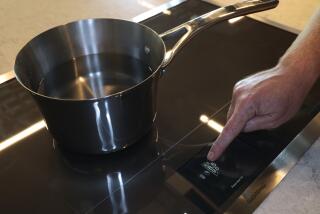Home Improvement : Appliances Graded for Efficiency
- Share via
QUESTION: I’m building a new home. It’s being well-insulated and I’ve purchased an efficient furnace for space heating. I’d like to equip it with energy-efficient appliances. Do you know if a rating list for household appliances exists?
ANSWER: Yes. Several organizations publish appliance efficiency lists. Because conservation is our least expensive source of providing energy, we encourage you to buy energy-efficient appliances.
Studies show household appliances and water heaters account for over 60% of the electricity used in energy-efficient homes. Water heaters and refrigerators use the most. The energy to run a refrigerator, for example, over its lifetime of 15-20 years, can be three times as much as its original price.
You may have noticed the bright yellow Energy Guide labels on appliances in the store. These labels help you compare the energy costs and energy-efficiency rating of appliance models in a similar size range. The information is based on a standardized efficiency test conducted by independent, nationally recognized testing labs.
Most types of new appliances must bear Energy Guide labels, even the most energy wasteful ones. When shopping for new appliances, look closely at these labels. You will probably find a less expensive appliance more costly to operate when compared to another model of the same size. Many times it will make sense to spend more on an energy-efficient appliance if it will save money in the long run.
In your home, the energy used for space heating will be small since it’s well-insulated and the furnace is energy efficient. Given this, the relative amount of energy used by appliances will be larger. This makes buying energy-efficient appliances an especially good idea for you.
The Bonneville Power Administration gives awards each year to the top 15% energy-efficient refrigerators and freezers. They make it easy for consumers to find the award winners by providing retailers with blue ribbons to place on display models in their stores.
BPA publishes a rating list called “The Top 15% Energy-Efficient Refrigerators and Freezers.” For a free copy, call BPA’s toll-free publications number at 1--800--547-6048. Ask for publication number BP-1612.
The brochure organizes models by product type and then size category. Within each size category models are listed by brand name in alphabetical order. BPA updates the list every six months.
The American Council for an Energy-Efficient Economy published the 1991 Consumer Guide to Home Energy Savings. It lists the top refrigerators, freezers, dishwashers, clothes washers, and gas, oil and electric water heaters. You’ll also find rankings for room air conditioners, central air conditioners, heat pumps, and gas and oil furnaces. Priced at $6.95, you can find it at local bookstores or check your local library. The 1992 edition is due soon.
Clothes Dryer Vent Should Run Outdoors
Q: We are purchasing a new home to be built this summer. The plans have the clothes dryer venting into the garage. Is this a cause for concern?
A: Clothes dryer exhaust contains large amounts of moisture and lint particles from clothing. Given this, it is best to locate the dryer on an outside wall and exhaust it directly outdoors. This is particularly important in climates where moisture levels are high to begin with.
Exhausting the dryer into the garage might result in moisture problems such as weeping windows, mold and mildew growth and, in a worse case, dry rot of wood framing materials. Over time, lint will build up on walls, window ledges, light fixtures and things stored in the garage. If you’re planning to set up a work space, these surfaces would become covered with lint as well. Tools might also be damaged over time by exposure to excessive moisture.
There are products available that attach to the dryer exhaust for harnessing the heat for use indoors in the winter. While they are designed to extract the moisture and lint from the exhaust, they are generally ineffective. We recommend avoiding these products and exhausting the dryer directly outdoors.
More to Read
Inside the business of entertainment
The Wide Shot brings you news, analysis and insights on everything from streaming wars to production — and what it all means for the future.
You may occasionally receive promotional content from the Los Angeles Times.








